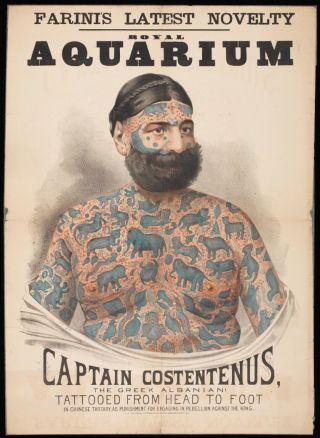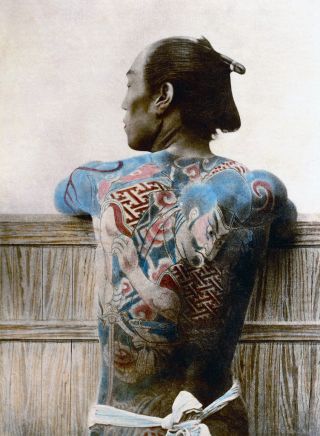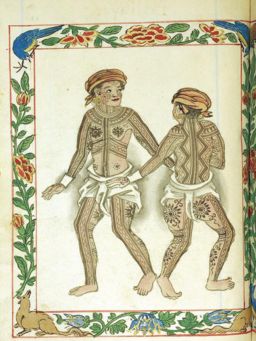Identity
Tattoos: The Skin as Canvas
The body becomes a personal tapestry.
Posted January 26, 2023 Reviewed by Michelle Quirk
Key points
- Tattooing the body with indelible pigments has been around worldwide for centuries but has become mainstream recently.
- Tattoos can reflect an act of rebellion, personal identity or group affiliation, reclaiming the body after surgery or injury, and punishment.
- Techniques for application and removal are more hygienic now, but complications, including infection and allergic reactions, can occur.

When our story by Roald Dahl opens after World War II, the tattoo artist Drioli is a disheveled old man who has fallen upon hard times. While walking, he passes an art gallery featuring paintings by Chaïm Soutine, his old friend. When he and Soutine, then a young, impoverished artist, were drunk more than 30 years earlier, he had convinced Soutine to paint a picture directly on his back—"I am the canvas"—and taught him the art of tattooing the image.
Desperate now, Drioli enters the gallery, and about to be forcibly ejected, flings off his shirt. The owner, so taken with the image, "the colors as bright as ever," and signed by Soutine, seduces Drioli into agreeing to let him purchase it. Removing the tattooed image from Drioli’s back, though, comes at a price.
The ending of this gruesome short story is left vague. The author leads us to believe the painting survives; Drioli does not. (Skin, 1953, 2000).

What, though, do we know about the skin as a canvas? Skin is the body's largest organ and its most visible. As such, it provides a decorative surface, i.e., a veritable "ever-changing personal tapestry" and "social placard" for painting, tattooing, scarring, and piercing (Jablonski, 2013).
It is also our boundary between the body and the environment and can reflect our health, age, and cultural identity (Jablonski).
No one knows when tattooing the skin began because skin deteriorates, but some sources suggest it has existed for 5,000 years (Zhitny et al., 2021) or even much earlier (Schmidt, 2013). Remnants of tattoos are found on Egyptian mummies from the Second Millennium B.C. (Sperry, 1991)

The earliest written mention (Sperry) appears in the Old Testament (Leviticus 19:28): "You shall not make any cuttings in your flesh on account of the dead or tattoo any marks upon you."
Captain James Cook found "indelibly painted" people during his travels to the Pacific in the 18th century. The word "tattoo" derives from a Polynesian word (Oxford English Dictionary).
Tattoos are "the first social network...simultaneously both public and private...static and fixed." Every movement potentially transforms them (Murphy, 2013). Some people prefer their tattoos visible while others prefer to keep them hidden.
Throughout history, tattoos have served different purposes, including establishing individuality and creating a nonverbal personal narrative, identifying group affiliation by signifying membership in or exclusion from a group, rebelling against authority, and testing one's endurance for pain (Schmidt; Wohlrab et al., 2007). Sometimes, tattoos are used to "reclaim" the body after illness, injury, or disfiguring surgery (Murphy).
Tattoos have also been used to brand slaves or prisoners as punishment (Schmidt).

The most notorious use of tattooing occurred by the Nazis at Auschwitz—a "dermatological symbol of man's inhumanity to man" (Hoenig, 2011, a). Initially done by a metal stamp and later by a needle that pierced the skin and inflicted serial numbers on an inmate's left forearm, this dehumanizing procedure was extremely painful. No anesthesia was used, and the technique was hardly sterile. It had been instituted to facilitate the identification of the enormous number of corpses whose clothes had been removed (Hoenig, a; US Holocaust Memorial Museum, 2019). At one camp, forced laborers were tattooed with the letters NL, which stood for the German word for "concentration camp" to prevent their escape (Hoenig, 2011, b).
Because of the words of Leviticus, many Jews believe tattoos are forbidden by Jewish law. One Jewish woman, though, in memory of the Holocaust, has appropriated images of the horrors and tattooed her entire body (Truesdell, 2015)—a "parchment for memorialization" (Murphy).
Tattooing involves a repetitive, mechanical piercing of the epidermis with needles that introduce permanent pigments into the dermis layer (Torre-Castro et al., 2022). The process causes a typical erythematous and inflammatory reaction that heals over time (Sperry, 1992). The tattoo's color varies with the pigments, especially the metallic salts used, but the “exact composition” of tattoo inks is not fully regulated (Torre-Castro et al.). Tattoo inks are considered cosmetics, and “little is known of the toxicological risks” involved in using these mostly organic pigments, including heavy metals (Laux et al., 2016).

As tattooing has gone from being “maverick involving social fringe groups” to “mainstream,” (Laux et al.), regulations have focused on hygiene and the prevention of infections. There is, though, always the risk of contaminants and impurities, including infected ink, as well as “pigment overload” (Serup et al., 2016). Bacterial infections, including staph and strep, are common enough since the skin's surface is not sterile, but viral infection with hepatitis B is also possible. Further, hypersensitivity and allergic reactions to tattoo pigments can occur (Torre-Castro et al.).

Though tattoos are permanent, removal is possible. Even famed 19th-century humorist Mark Twain wrote of using a candle and needles, a technique he had used years earlier to remove warts, to burn off a tattoo he had grown "tired and ashamed of" (Scharnhorst, 2004).
Tattoo removal, often due to "tattoo regret" (Klein and Kenedi, 2018), which is seen in up to 50 percent of people (Laux et al.), is now done by laser. Considerably safer than previous techniques, it is still not without difficulties, including possible blistering, scarring, pain, paradoxical darkening, allergic reactions, and bleeding (de Moll, 2018), and may require more than 10 treatments (Laux et al.).
References
Dahl R. Skin and Other Stories. New York: Speak, Published by the Penguin Group, 2000, pp. 1-21.
de Moll EH. Tattoos: from ancient practice to modern treatment dilemma. Cutis 101(5): E14-E18, 2018.
Hoenig LJ. Tattooing, Auschwitz Style. International Journal of Dermatology 50: 1166-1167, 2011 (a).
Hoenig LJ. The KL concentration camp tattoo. Archives of Dermatology 147(7): 781, 2011 (b).
Jablonski NG, Skin: A Natural History. Berkeley: University of California Press, 2013.
Klein CA; Kenedi C. Understanding tattoos in medico-legal assessments. Journal of the American Academy of Psychiatry and the Law 46(1): 93-101, 2018.
Laux P et al. A medical-toxicological view of tattooing. The Lancet 387: 395-402, January 23, 2016.
May HG; Metzger BM (editors): The New Oxford Annotated Bible with the Apocrypha, revised. (Leviticus 19:28). New York: Oxford University Press, 1977, p. 147.
Murphy M. Tattoos as social networks. Fort da 19(1): 29-38, 2013.
Oxford English Dictionary, Tattoos. https://www.oed.com/view/Entry/198122?result=2&rskey=u2btpQ&. (Retrieved 1/24/23).
Scharnhorst G. Mark Twain's 'How to remove warts and tattoo marks' authenticated. ANQ: A Quarterly Journal of Short Articles, Notes, and Reviews 17(3): 41-43.
Schmidt S. Tattoos—An historical essay. Travel Medicine and Infectious Disease 11: 444-447, 2013.
Serup J; Sepehri M; Carlsen KH. Classification of tattoo complications in a hospital material of 493 adverse events. Dermatology 232: 668-678, 2016.
Sperry K. Tattoos and Tattooing, Part I: history and methodology. The American Journal of Forensic Medicine and Pathology 12(4); 319-319, 1991.
Sperry K. Tattoos and Tattooing, Part II: gross pathology, histopathology, medical complications, and applications. The American Journal of Forensic Medicine and Pathology 13(1): 7-17, 1992.
Torre-Castro J et al. Histopathology of dermatological complications of tattoos. American Journal of Dermatopathology 44(9): 632-649, 2022.
Truesdell S. Jews and Tattoos: ‘Rooted in Conflict.' Harvard Divinity Bulletin Summer/Autumn, 2015: https//bulletin.hds.harvard.edu/jews-and-tattoos-rooted-in-conflict. (Retrieved 1/23/23).
United States Holocaust Memorial Museum. Tattoos and numbers: the system of identifying prisoners at Auschwitz. Washington, DC: 12/9/2019: https://encyclopedia.ushmm.org/content/en/article/tattoos-and-numbers-the-system-of-identifying-prisoners-at-auschwitz. (Retrieved 1/23/23).
Wohlrab S; Stahl J; Kappeler PM. Modifying the body: motivations for getting tattooed and pierced. Body Image 4(1): 87-95, 2007.
Zhitny VP; Iftekhar N; Sombilon EV. History, folklore, and current significance of facial tattooing. Dermatology 237: 79-80, 2021.


